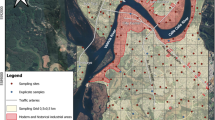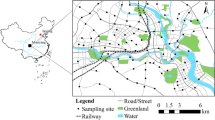Abstract
The distribution of 41 trace and 11 major elements in 4000 samples of topsoils (0–20 cm) from the Berlin Megacity is interpreted. The detailed comparative analysis of the element distributions and the results of factor analysis showed that the distributions of the elements Al, K, Na, Rb, Zr, Nb and Ti are mainly natural origin, i.e. related to the composition of the parent material. Industrial and commercial areas often display considerably elevated values for Mo, Ni, As, Ag, Cr, Sb, Fe, Mn, Mg, P, TOC and especially Pb, Hg and electrical conductivity relative to the geogenic background of the area surrounding Berlin. Industrial areas tend to be characterised by contamination of the subsoil with Cu, Cd, Zn, Hg, Pb and Sn. In the area around Berlin, extensive, strong anamalies of Cd, Zn, Pb, Cu and Hg occur near iron and steel industries and construction materials industries, as well as in the vicinity of sewage farms.
Similar content being viewed by others
References
Birke, M., Bityukova, L. and Grunsky, E.: 1998, Urban Geochemistry of Tallinn, Estonia, Final Report, NATO (EVIR. CRG. 960910), 67 pp., Brussels.
Birke, M and Rauch, U.: 1994, Geochemical investigations in the urban areas of Berlin, Mineral Magazine 58A, 95–96, London (Mineralogical Society).
Birke, M. and Rauch, U.: 1997, Geochemical investigations in the Berlin metropolitan area, Z. Angew. Geol. 43(1), 58–65, Hannover.
Bityukova, L., Scholger, R. and Birke, M.: 1999, Magnetic Susceptibility as Indicator of Environmental Pollution of Soils in Tallinn-Physics and Chemistry of the Earth, vol. 24, Elsevier Science Pergamon Press.
Brose, F. and Brühl, H.V.: 1993, Untersuchungen zur geogenen und anthropogenen Grundlast umweltrelevanter Schadstoffe in oberflächennahen Lockergesteinen und Grundwässern im westlichen Stadtgebiet von Berlin, Z. dt. Geol. Ges. 144, 279–294, Hannover.
Earickson, R.J. and Billick, J.H.: 1988, The areal associated of urban air pollutants and residential characteristics: Louisvill and Detroit, Applied Geogr. 8, 5–23.
Heckel, J., Brumme, M., Weinert, A. and Irmer, K.: 1991, Multielement trace analysis of rocks and soils by EDXRF using polarized radiation. X-ray Spectrometry, 20, 287–292, Chichester, Sussex, Wiley.
Kadunas, V., Budavicius, R. and Gregorauskiené, V. et al.: 1999, Geochemical Altas of Lithuania, Geological Survey of Lithuania, Geological Institute, Vilnius, 162pp.
Kelly, J., Thornton, J. and Simpson, P.R.: 1995, Urban Geochemistry: A Study of the Influence of Anthropogenic Activity on the Heavy Metal Content of Soils in Traditionally Industrial and Nonindustrial Areas of Britain, Applied Geochemistry, Oxford, New York, Seoul, Tokyo, Pergamon (in press).
Lis, J.: 1992, Geochemical Atlas of Warsaw and Environs 1:100 000, Paustwowy, Geological Institute, Warsaw, 33p.
Li, Xiang-Dong, Poon, Chi-Sum, Chan, R. et al.: 1997, Concentration and Chemical Partitioning of Heavy Metals in Road Dusts and Urban Soils in Hong Kong, 4th International Symposium on Environmental Geochemistry, Open File Report 97–496, Vail, pp. 54.
Lukashev, V.K.: 1994, Soil and Plants Geochemical Monitoring in Urban Environments, Abstracts of the 3rd International Symposium on Environmental Geochemistry, Krakow, pp. 245.
Lux, W.: 1993, Long-Term Heavy Metal and As Pollution of Soils, Hamburg, Germany. Applied Geochemistry, Suppl. 2: 135–143; Oxford, New York, Seoul, Tokyo, Pergamon Press.
Mielke, H.W.: 1997, Urbane Geochemie: Prozesse, Muster und Auswirkungen auf die menschliche Gesundheit, in: Matschullat, J., Tobschall, H.J. and Voigt, H.-J. (eds) Geochemie und Umwelt: Relevante Prozesse in Atmo-, Pedo-und Hydrosphäre, Berlin, Springer-Verlag, 169–179.
Mielke, H.W.: 1994, Lead in New Orleans soils: new images of an urban environment, Environmental Geochemistry and Health London 16, 123–128.
Mielke, H.W., Dugas, D., Mielke, P.W. et al.: 1977, Associations between soil lead and childhood blood lead in urban New Orleans and rural Lafourch Parish of Louisiana, Environmental Health Perspetives 105(9), 950–954.
Mielke, H.W., Reagan, P.L.: 1988, Soil as an impact pathway of human lead exposure, Environmental Health Perspectives 106(1), 217–229.
Reimann, C.L., De Caritat, P.: 1998, Chemical elements in the environment, Factsheet for the Geochemist and environmental scientist, Berlin: Springer-Verlag, 397 pp.
Thornton, J.: 1991, Metal contamination of soils in urban areas, in: Bullock P and Gregory P.J. (eds) Soils in the Urban Environment, Oxford, Blackwell Scientific Publ, pp. 47–55.
Viverette, L., Mielke, H.W., Brisco, M. et al.: 1996, Environmental health in minority and other underserved populations: benign methods for identifying lead hazards at day care centres of New Orleans, Environmental Geochemistry and Health, London 18, 41–45.
Author information
Authors and Affiliations
Rights and permissions
About this article
Cite this article
Birke, M., Rauch, U. Urban Geochemistry: Investigations in the Berlin Metropolitan Area. Environmental Geochemistry and Health 22, 233–248 (2000). https://doi.org/10.1023/A:1026554308673
Issue Date:
DOI: https://doi.org/10.1023/A:1026554308673




